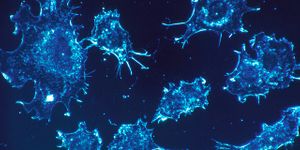Carnegie Mellon University physicists Mathias Lösche and Frank Heinrich have led an international group of researchers in establishing the structure of a tumor suppressing protein, PTEN, according to a
press release from Carnegie Mellon, as reported in
Bioscience Technology. Their findings provide new insights into how the protein regulates cell growth and how mutations in the gene that encodes the protein can lead to cancer. Their findings are published online in
Structure, and will appear in the October 6 issue.
Phosphatase and tensin homolog (PTEN), a known tumor suppressing protein, is encoded by the PTEN gene. When PTEN is expressed normally, it acts as an enzyme at the cell membrane, triggering a complex biochemical reaction that regulates the cell cycle and keeps cells from growing or dividing in an unregulated manner. Every cell in the body has two copies of the PTEN gene, one from each parent. If there is a mutation in one or both of the PTEN genes, it interferes with the protein’s enzymatic activity and interferes with its tumor suppressing ability.

According to Lösche, who seeks to understand the structure and function of cell membranes and membrane proteins, “Membrane-incorporated and membrane-associated proteins like PTEN make up one-third of all proteins in our body. Many important functions in health and disease depend on their proper functioning. Despite PTEN’s importance in human physiology and disease, there is a critical lack of understanding of the complex mechanisms that govern its activity.”
Researchers led by Pier Paolo Pandolfi at Harvard Medical School recently discovered that PTEN’s tumor suppressing activity gets elevated when two copies of the protein bind together, forming a dimeric protein. Lösche, a professor of physics and biomedical engineering at Carnegie Mellon, believes that PTEN dimerization could help researchers to understand an individual’s susceptibility for PTEN-sensitive tumors. To reveal the way in which dimerization improves PTEN’s ability to stop tumor development, researchers needed to determine the protein’s dimeric structure. Protein structure is usually identified with crystallography, but attempts to use that method with the PTEN dimer had been unsuccessful.
Lösche’s group used small-angle X–ray scattering (SAXS) to gains information about protein structure by scattering X-rays through a solution containing the protein. The researchers used computer modeling to establish the dimer’s structure. They discovered that in the PTEN dimers, the C-terminal tails of the two proteins might bind the protein bodies in a cross-wise way, making them more stable. Thus, they can interact more efficiently with the cell membrane, regulate cell growth and restrain tumor formation. With more knowledge about the structure of the PTEN dimer, researchers can use molecular biology tools to study the atomic-scale mechanisms of tumor formation facilitated by PTEN mutations. They hope that their findings will provide a new direction for cancer therapeutics.









